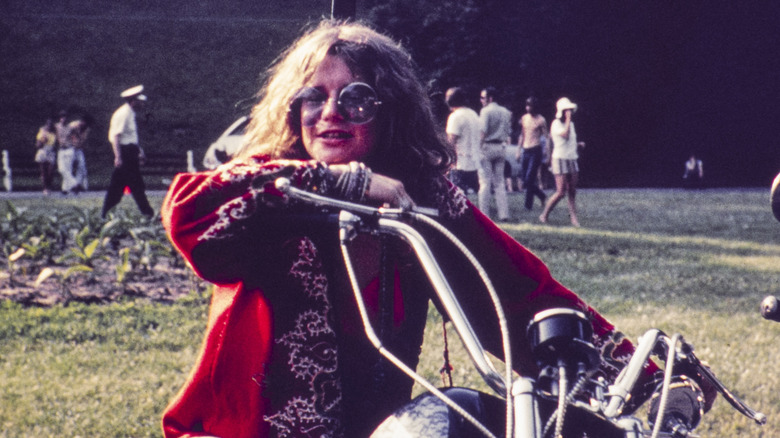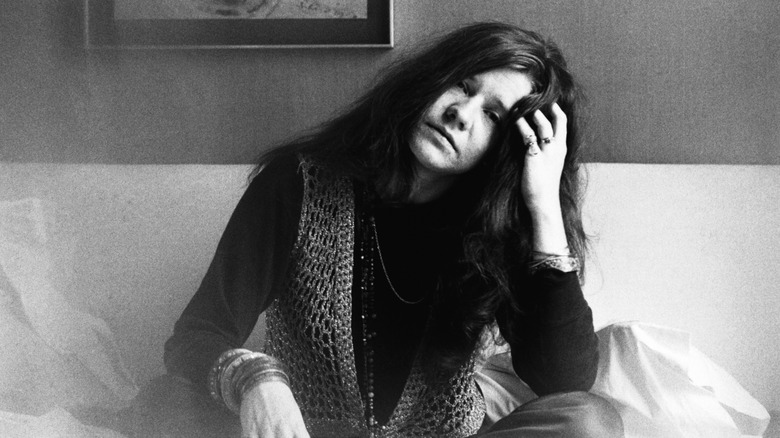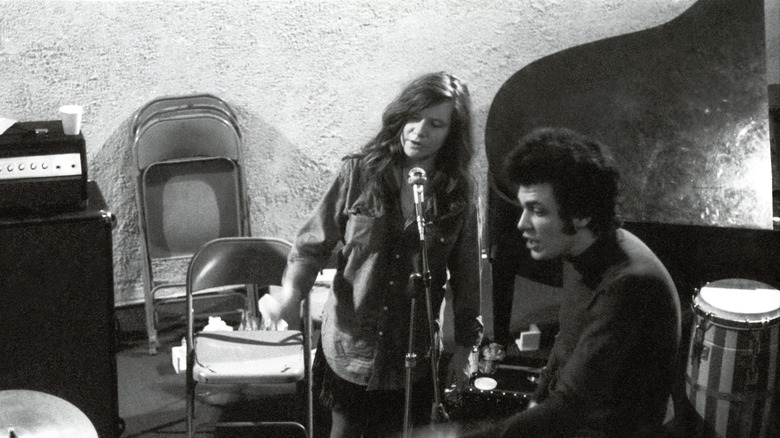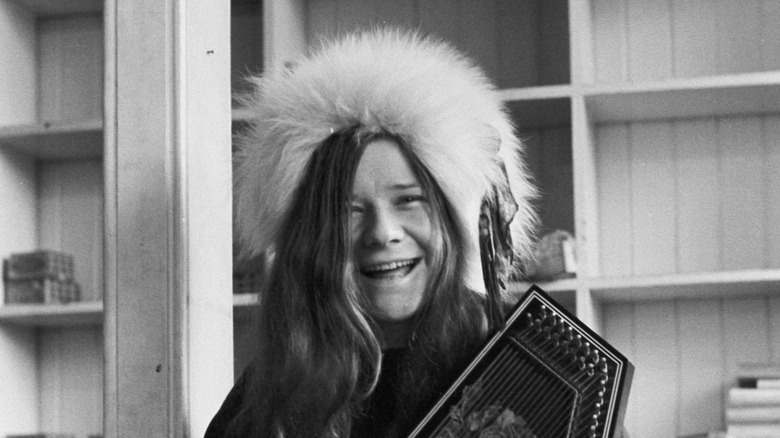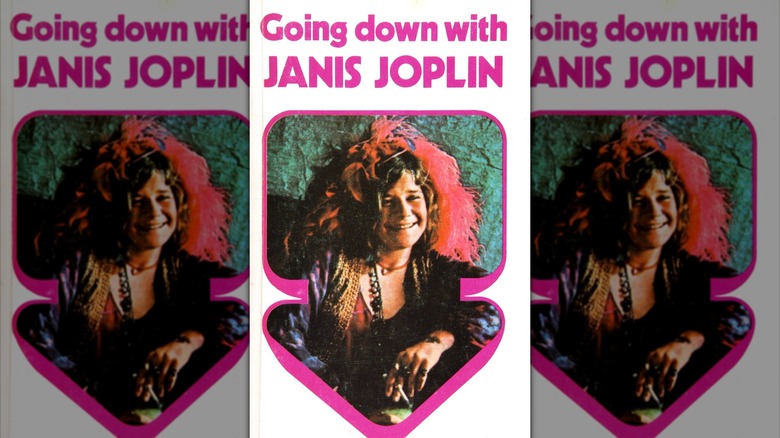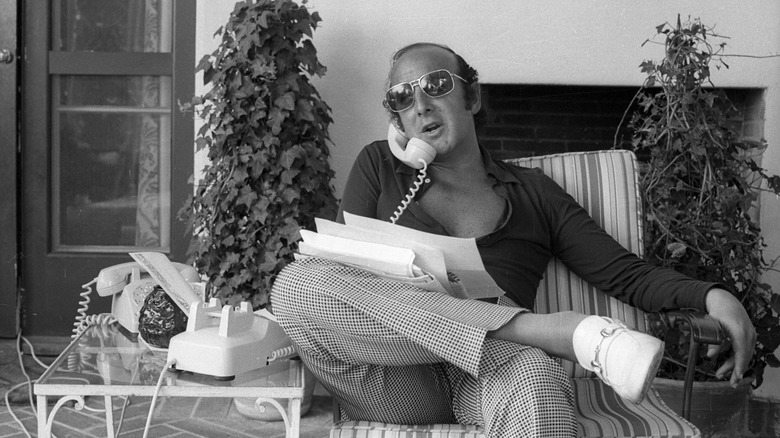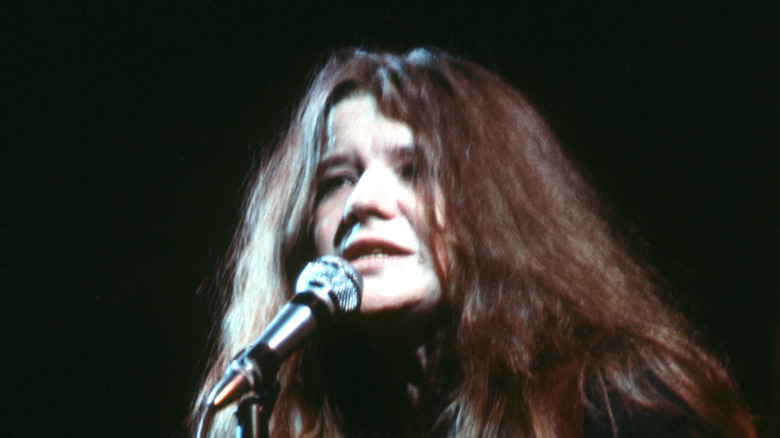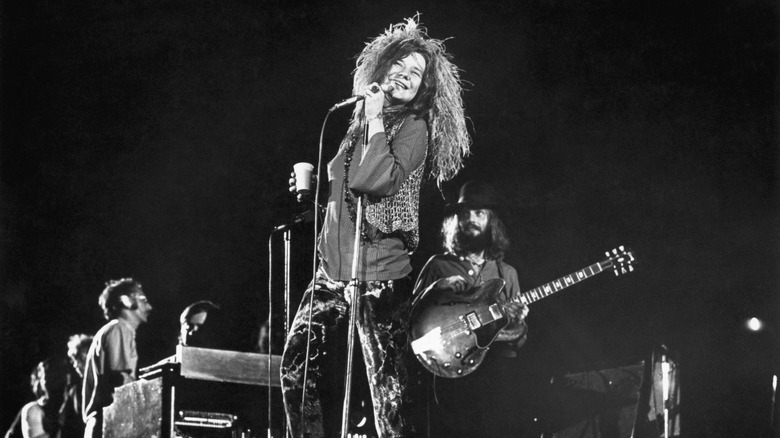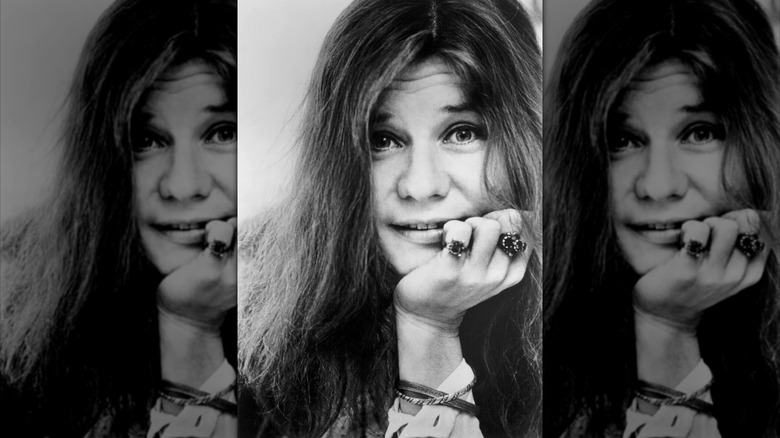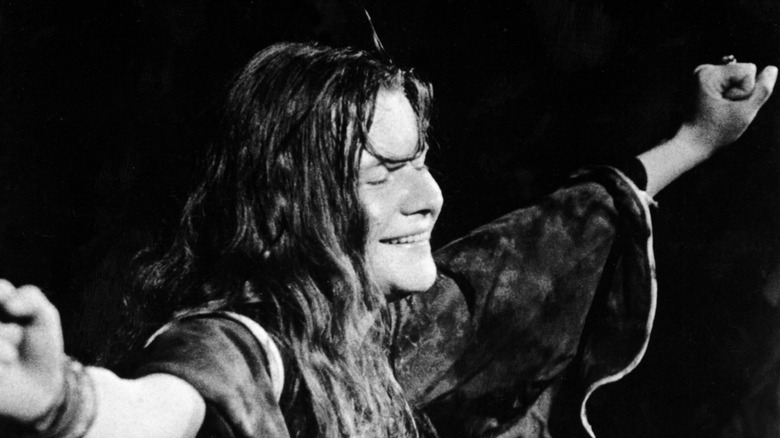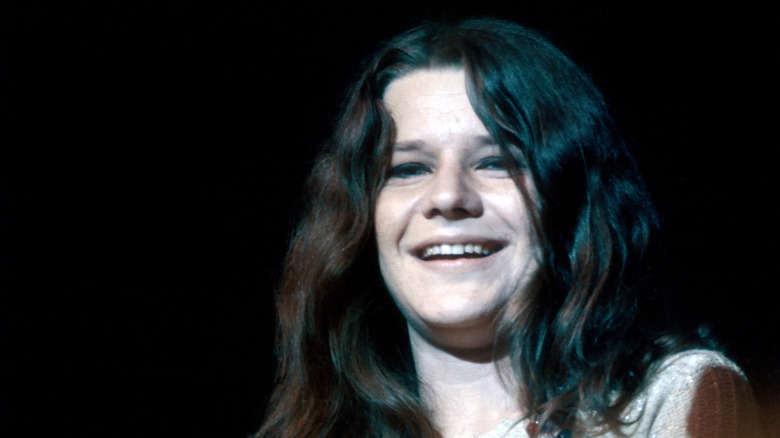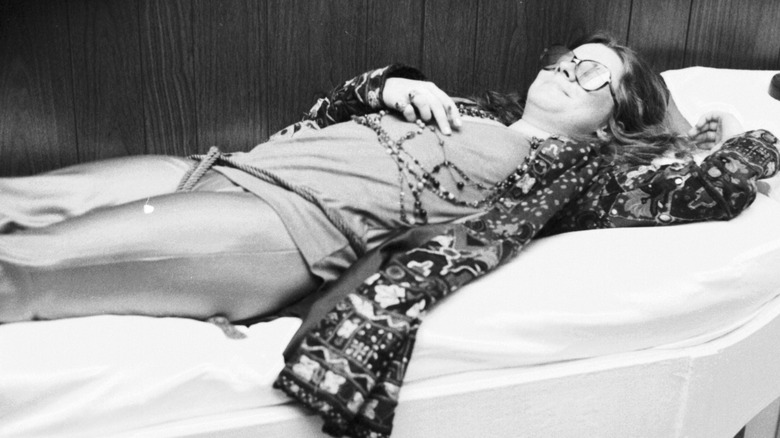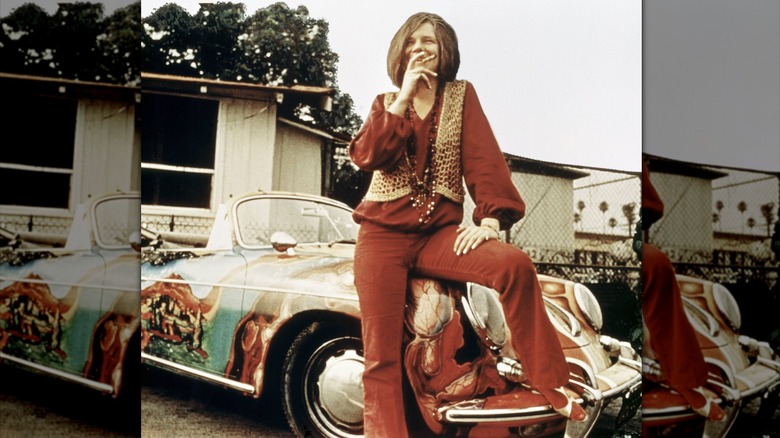Things We Only Learned About Janis Joplin After She Died
Janis Joplin made an indelible imprint on the fabric of rock music. What is all the more impressive is that she managed to do it during a shockingly short career, spanning just a few years and a mere four albums. In that brief time, the Texas native achieved superstardom, first as the lead singer for San Francisco psychedelic rock band Big Brother and the Holding Company and then as a solo artist. She'd also managed to shine at some of the most culturally significant events of the late 1960s, including her star-making performance at the Monterey Pop Festival and an incendiary set at Woodstock.
She packed a lot into just 27 years during a brief but freewheeling life spent bucking societal norms. Sadly, she was also known to have appetites as expansive as her talent, which included an ever-present bottle of Southern Comfort by her side and a taste for narcotics, ultimately resulting in her tragic death from a heroin overdose.
Still, she carved a large swath through pop culture during that time, and it wasn't until after her exit that some truly fascinating facts emerged. To find out more, keep on reading to discover some things we only learned about Janis Joplin after she died.
She paid for her own wake
Janis Joplin's will contained a somewhat unique provision, yet perfectly in sync with her hard-living lifestyle: she threw herself a posthumous party. In the final section of the will, Joplin instructed that her remains be cremated, and also allotted $2,500 from her estate "to cause a gathering of my friends and acquaintances at a suitable location as a final gesture of appreciation and farewell to such friends and acquaintances." According to the Rock Hall, the wake was held at Lion's Share in San Anselmo, California and was by invitation only. Guests included her former band members, members of the Grateful Dead, lots of Hell's Angels, and the staff of the Haight Ashbury Free Medical Clinic.
In the months after her death, friends of Joplin would frequent her home in Larkspur, outside of San Francisco. Among the attendees was the late singer's friend, actor Peter Coyote. Speaking with author Myra Friedman for her book, "Buried Alive: The Biography of Janis Joplin," Coyote compared the atmosphere at the party to a scene in the film "Zorba the Greek," "where the old chick croaks and all the f***ing buzzards are there."
Coyote admitted he was appalled by the behavior he witnessed from her so-called friends. "People were coming over to that house and walking around and taking s***! You know, I want this and I want that," Coyote recounted. "I couldn't believe it. People came over and took things, people I thought would be above that. Hell, I know she would have given the stuff away. But, it hipped me to a relationship that was going on during her lifetime and I thought to myself, 'Phewww, that's a lousy way to treat somebody.'"
Her final recording was a birthday greeting for John Lennon
Just before her death, Janis Joplin was completing sessions for her second solo album, the posthumously released "Pearl," at Sunset Sound in Los Angeles. The final track she laid down was the a cappella classic "Mercedes Benz," yet that wasn't her final recording.
In his book, "On the Road with Janis," Joplin's road manager, John Byrne Cooke, wrote that Yoko Ono had enlisted various rock stars in L.A. — including Joplin — to tape a message to send John Lennon for his 30th birthday. Cooke recalled hearing that recording when he and the members of Joplin's Full Tilt Boogie Band were in Sunset Sound as "Pearl" producer Paul A. Rothchild played tapes from the sessions. "The first song Paul plays for us at Sunset Sound is Janis and Full Tilt's contribution, which we recorded a couple of days before Janis died, all of us singing along behind Janis. It is raucous and joyful. We hold the final 'happy birthday to youuuuuuu,' and Janis says, 'Happy birthday from Janis and Full Tilt Boogie! Happy birthday, Johnny!" Cooke wrote, noting that the recording ended with a rendition of the Roy Rogers-Dale Evans cowboy ditty "Happy Trails."
Lennon never met Joplin in person but confirmed while appearing on "The Dick Cavett Show" via YouTube, that he'd received the tape. "We got it after she died," Lennon recalled. "It arrived in the post, and she was singing 'Happy Birthday' to me in the studio."
She was trying to 'live a more balanced life' when she died
The grand irony underlying the tragic life story of Janis Joplin is that, prior to her drug-related death, she'd been focusing on trying to achieve a better live/work balance. Speaking with Classic Rock, the late singer's sister, Laura Joplin, revealed she'd been eager to slow down — both in terms of her breakneck schedule of touring and recording and also when it came to her intake of drugs and alcohol. "It was hard to have relationships when traveling that much, and she was having ideas of... trying to live a more balanced life in terms of the amount of time she toured," she said.
She'd also cut back her drinking during the "Pearl" sessions, wary of how alcohol could damage her voice and wanting to be at the top of her game, neither loaded nor hungover. As a result, instead of having a few drinks to relax after a day in the studio, she'd indulge in heroin, intending to quit entirely once the album was completed.
"There's certainly a lesson in her life for me," her brother, Michael Joplin, told Classic Rock. "It's important to be true to yourself, as she said many times, and at the same time — what she didn't quite get as clearly — to realize that you have to live with the consequences of your behavior. And she died from them."
Claims of same-sex relationships
Janis Joplin was linked with many famous men, including The Grateful Dead's Ron "Pigpen" Kernan and Kris Kristofferson. According to Joplin's friend, Peggy Caserta, she'd also had sexual relationships with women — including Caserta. She made that assertion in her 1973 tell-all, "Going Down with Janis Joplin," depicting Joplin as a closeted lesbian who publicly pursued men to hide her sexuality. Those who knew Joplin, however, were dubious; Joplin's sister, Laura Joplin, was particularly skeptical. "There are a number of people who have tried to present Janis as a frustrated lesbian, unable to be totally out front, but for the most part they have not maintained it once they have really started looking at her life," she told Classic Rock.
Caserta — who died in 2024 — later admitted the book was ghostwritten. "I didn't write that trash. I sold out for drug money," she told Vulture in 2018. Caserta also seemingly disavowed the book's claims. "I never even said that we were lovers, in the lesbian sense. I never believed that," she said, later insisting of Joplin, "she was straight."
Sam Andrew, guitarist in Big Brother & The Holding Company and The Kozmic Blues Band, held a more nuanced view. "I think there is an element of truth in the fact that Janis hid her interest in women from all of us, but I just can't be sure," he told Classic Rock. "I have to say that she was quite interested in men, and genuinely so."
She suggested sex with record exec Clive Davis to seal her record deal
The fact that Janis Joplin was an eager partaker of the hippie counterculture's free-love philosophy is hardly a secret. Years after her death, however, famed record executive Clive Davis shared an anecdote illustrating just how casually she viewed sex. Interviewed by The Guardian in 2014, Davis confirmed that she'd offered to have sex with him as a way of celebrating the moment.
"Ha, that's true," Davis said. "Janis — who never wanted to do anything formulaic, typical or predictable — was starting out in her career and it was a very important moment for her. I think it was a little too formal and maybe corporate just to sign a document to say we'd be working together, so she asked to sleep with me to make it more personal. I took it as a big compliment, although I turned it down."
She'd previously overdosed on heroin before and barely survived
While Janis Joplin's fans may have been shocked by her death at age 27 from a heroin overdose, her friends likely weren't. "I might be going too fast," Joplin observed in an interview with The New York Times (via The Telegraph). "That's what a doctor said ..." she continued, jokingly adding, "I don't go back to him anymore." Holly George-Warren, author of the biography "Janis: Her Life and Music," came to believe that Joplin was an alcoholic who saw heroin as the lesser of two evils. "She actually tried to keep the drinking in check because liquor is much worse on your voice than heroin," George-Warren told Texas Monthly.
Around that same time, Joplin's friend, Linda Gravenites, paid a visit to the singer's home and discovered her collapsed, her face turning purple, after overdosing on heroin. Gravenites revived her and took her out walking for hours, which very likely saved her life — at least temporarily.
Speaking with Classic Rock, Joplin's longtime guitarist, Sam Andrew, recalled that the lure of heroin was far too seductive for her to resist. "What Janis liked about heroin was that it turned her mind off," Andrew explained. "She was a compulsive thinker, analyzer, and critic, and heroin enabled her to become soft, unfocused, intuitive, and receiving. She didn't like marijuana because 'it makes me think.'"
She'd quit heroin before a relapse led to her fatal overdose
Janis Joplin's near-fatal overdose had apparently been a wakeup call. "She tried to kick heroin a few times. She finally did almost for good in 1970," Joplin biographer Holly George-Warren told NPR's "Fresh Air." Joplin decided to travel with Gravenites to Rio de Janeiro for Carnaval — leaving her stash of heroin, $2,500 worth — with Peggy Caserta and enjoy a drug-free journey through Brazil. That was when she met David Niehaus, an American backpacker — who wasn't impressed by her fame. "He saw Janis the woman, not the rock star," Amy Berg, director of documentary, "Janis: Little Girl Blue," told The Telegraph. "He wasn't a hippy, he was a world traveler, a mountain man in a way, and he was strong enough to handle her."
When he returned with her to San Francisco, Niehaus was met with resistance from her drug-using friends, who felt he didn't fit into their insular scene. Niehaus eventually broke it off when Joplin began drifting back to heroin during the "Pearl" recording sessions. "She spoke of him as her lost love," Joplin's former road manager, John Byrne Cooke, told The Telegraph. "And she still hoped he would come back after she got clean."
Unbeknownst to Joplin, the final batch of heroin she received was of exceptionally high purity. "It was much more pure than she had ever used before, and her tolerance was down," said George-Warren. "She was by herself, overdosed, and died ..."
Her alleged lover Peggy Caserta claimed Joplin's death wasn't due to heroin
Any hopes that Janis Joplin would kick heroin were dashed when Peggy Casertas re-entered Joplin's life in the fall of 1970, bringing heroin with her — or at least that was the opinion of Joplin's road manager, John Byrne Cooke. "Peggy was banished from Janis's house in the spring, along with the rest of Janis's druggie friends," Cooke wrote in his book, "On the Road with Janis," having earlier observed, "When it comes to hard drugs, Peggy will be a conspirator with Janis, not a restraining force."
While Joplin's death has long since been attributed to heroin, Casertas subsequently claimed that Joplin's demise resulted from another cause entirely. "She didn't overdose," Caserta declared to Vulture.
From what Caserta had seen while authorities secured the scene at Joplin's room in LA's Landmark Hotel, she came to conclude that Joplin tripped and fell. "She hit her head on the night table and broke her nose," Caserta noted. "I figure the blood backed up in her throat and cut off her air supply. I'm sure the fact that she had heroin and other things in her system didn't help her any. Maybe if she hadn't been loaded and on something, she might have been able to struggle up. But she tripped and fell, honey. I'm positive of it."
She had remained in close contact with her parents
While Janis Joplin personified the rock 'n' roll rebel, it didn't emerge until after her death that she'd consistently remained in touch with her parents back in Texas. It's true that Joplin herself contributed to that defiant image, creating a mythology by telling her friends that she'd been on her own since the age of 14 when her parents kicked her out of the house.
That hadn't happened. In her documentary, "Janis: Little Girl Blue," filmmaker Amy Berg was provided access to never-before-seen letters that Joplin wrote her parents, chronicling her rise to stardom and sharing her inner thoughts as she grappled with fame. In one of those letters, she suggested what they could send her for a Christmas present. "The only thing that I can think of that I want is a good, all round cookbook, Betty Crocker or any good one," she wrote, via The Telegraph.
"She wrote lengthy letters, and after she made enough money she made lots of telephone calls," the late singer's sister, Laura Joplin, told the newspaper, recalling how the family had driven from Texas to San Francisco to take in one of her performances. "But I think she felt very supported and loved by the family," Laura recalled. "She didn't expect her parents to become hippies, but they still had a strong bond. We all did. They wanted more than anything for her to be a success."
She was far more in control that her freewheeling image suggested
Another aspect of the mythology that came to surround Janis Joplin — and which she eagerly fed — had to do with her hard-partying, drug-taking persona. Joplin dubbed that alter ego Pearl, which "Buried Alive" author Myra Freeman described as "a hard-drinking-swearing-always-partying-f***-anybody-get-it-on-get-it-off-stay-stoned-keep-on-rocking floozy ..."
While Pearl was indeed one aspect of Joplin's personality, there was another side to her that was disciplined, hard-working, and ambitious. It was that facet of Joplin that intrigued biographer Holly George-Warren, author of "Janis: Her Life and Music." "Over her short life, Janis perfected an image of being this blues mamma, this wild woman who just lets the emotions roll over her, who sings what she feels, but I realized there is this other part of her that people don't know," George-Warren told Texas Monthly. "Behind the scenes, she was a hardworking musician who spent years honing her craft."
Speaking with NPR's "Fresh Air," George-Warren explained that Joplin deliberately tried to keep that side of herself a secret, preferring to let the public see Pearl. "She didn't want people to know how hard she worked, just like she tried to hide the fact that she was a total bookworm and ... read books all the time," she said. As she told Texas Monthly, that was evident in recordings from the "Pearl" sessions. "But on these tapes, Janis is in charge," she said. "I mean, she's clearly running the show."
She was on the cusp of 'retiring' — at least temporarily
Three months before her death, Janis Joplin embarked on a wild tour through Canada; dubbed Festival Express, she and several other acts — including The Grateful Dead, The Band, and blues guitarist Buddy Guy — traveled from city to city on a bus. In a scene from the 2003 documentary about the tour — "Festival Express" — Joplin is seen chatting with singer Bonnie Bramlett. "Women, to be in the music business, give up more than you'd ever know ... a home and friends, children and friends," she lamented (via Classic Rock).
As her sister, Laura Joplin, told the outlet, the singer had become burned out from performing and recording, which fed into a cycle of drinking and drugs. "There was a certain frustration in her about some aspects of her life," Laura said. Her friends, in fact, recalled that she'd fallen in love with a new boyfriend, novelist Seth Morgan, and was seriously contemplating getting married and settling down. However, they also believed that she was ultimately deluding herself and that her ambition would eventually win out and send her careening back to the stage. "I could see her going through a 'retirement' and it would turn out to be a temporary phase, too," said her friend, guitarist Sam Andrew. "The 'picket fence' doesn't exist. It's an illusion. People who want a safe harbor don't realize they would have to lose themselves completely to obtain that safety."
Janis Joplin's siblings have probably earned more money from her music than she did
It's a sad fact that music icons who die before hitting 30 can generate more income after shuffling off this mortal coil than they did while alive. Guitarist Jimi Hendrix — who, like Joplin, is among the lengthy list of stars to die at age 27 — had a net worth of just $20,000 at the time of his tragic death, while his estate has subsequently ballooned to an estimated $175 million, according to Musiclipse.
Likewise, Janis Joplin has made far more money for her estate than she ever earned for herself. Given that her professional career was only a few years old when she died, her net worth at the time of her death, Celebrity Net Worth estimated her estate $250,000. However, her posthumous album, "Pearl," was a huge hit that sold 4 million copies, raking in $6 million, per The Richest. Then there was the 1972 release of "Janis Joplin's Greatest Hits," which sold 7 million copies and generated an additional $10.5 million.
While various folks have inherited the fortunes of rock stars after they passed away, Joplin's siblings currently control her estate — which continues to rake in money from album sales, streaming, merch, copyright usage, etc. In fact, they sold her famed psychedelic Porsche at auction for a record-breaking $1.76 million in 2015.
If you or anyone you know needs help with addiction issues, help is available. Visit the Substance Abuse and Mental Health Services Administration website or contact SAMHSA's National Helpline at 1-800-662-HELP (4357).
